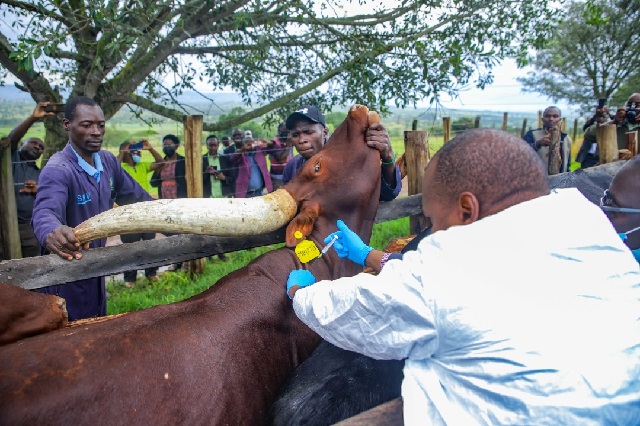
Mbarara, Uganda | Patricia Akankwatsa | Ministers, Members of Parliament, and National Agricultural Research Organisation (NARO) scientists late last week commissioned the trial of an anti-tick vaccine in Mbarara district to protect cattle from ticks and related diseases.
The first scientific launch on Thursday at the Mbarara Zonal Agricultural Research and Development Institute (MbZARDI) was graced by the Minister of Agriculture Frank Tumwebaze.
According to NARO’s deputy director general, Dr Yona Baguma, the trial vaccine has already passed initial test stages [laboratory tests, proof of concept, on-station clinical trials administered both orally and by intramuscular injection] of prequalification proceeding to the final geographical trial stage.
“The clinical trial protocols have been… reviewed for scientific integrity and the National Drug Authority (NDA)has reviewed and approved the trial designs, protocols, sites, and the personnel to undertake the multi-locational confined field trial,” Baguma said.
He added that the oral anti-tick vaccine was constituted and piloted on 18 Friesian calves at Nakyesasa, Wakiso district.
“The most efficacious among the several candidate vaccines is now ready to be evaluated for safety and effectiveness under natural tick and field challenges and is administered by injection and sensitization,” said Baguma.
Finally, MAAIF has granted us permission for the investigational product, while NDA has granted the research permit to conduct this trial, said Baguma.
The four developed injectable anti-tick vaccine candidates include; NARO-RA [Rhipicephalus appendiculatus], NARO-AV [Amblyomma variegatum], NARO-RD [Rhipicephalus decoloratus], and NARO-CV [a cocktail vaccine] which is an additional innovation against the brown, blue, and red ticks with promising results on sensitization.
Baguma said the vaccines have been specifically developed to protect against the three economic ticks in the country, such as brown ear tick, the blue tick, and the Bont-legged tick.
NARO scientists have so far produced 3,000 doses of the candidate vaccines in the current trial batch, which will be evaluated on different farms across the country.
The researchers are also progressively developing other vaccines against foot and mouth disease [FMD], African Swine Fever [ASF], Newcastle disease [NCD], Gumboro, and east coast fever [ECF].
Minister Frank Tumwebaze believes that the investment being the first of its kind will make Uganda a leading hub for livestock vaccines in the region.
“Upon successful completion of this field trial in the different geographical settings, the product will be licensed for integration into the present tick control programme in Uganda,” said Tumwebaze adding that his ministry will continue to support NARO.
Wilson Kajwengye, Member of Parliament for Nyabushozi County which has a total of 500,000 heads of cattle, said the ant-tick vaccine is a relief to the farmers who have previously lost animals to the ticks.
He however appealed to the government to always consider animal diseases as emergency cases like it is among humans. “Why do we get bogged down by protocols of approval to sign a response?”
According to Dr Andrew Akashaba, the district veterinary officer, Mbarara loses about 3,000 head of cattle to ticks. “We have some farms where people lose two head of cattle in a week due to ticks and tick-borne infections like east coast fever and anaplasmosis which translates into a loss of about Shs 4 billion every year without considering the losses associated with milk, meat, and other animal products.”
The Minister of State for Animal Industry Lt. Col Bright Rwamirama said the ant-tick vaccine will save the country an annual loss of Shs 3.8 trillion caused by ticks and tick-borne diseases.
Similar trials will take place at four other locations in Uganda: Prison Farm Isimba, Uganda Prison Farm Kiburara, Maruzi Livestock Research Centre, and Nabuin ZARDI in the district of Masindi, Ibanda, Apac, and Nabilatuk.
After the trials, the results will then be assessed for quality standardisation to make the vaccine safe for public use.
 The Independent Uganda: You get the Truth we Pay the Price
The Independent Uganda: You get the Truth we Pay the Price



